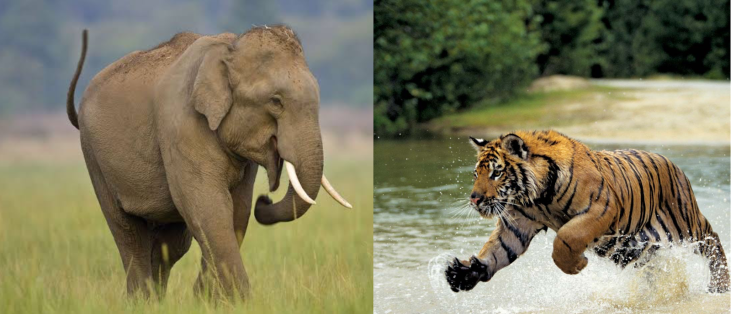India’s Wildlife Conservation Programs
India is home to a rich diversity of wildlife, and its government has initiated several programs to protect its endangered species. Among these, Project Tiger and Project Elephant stand out as key initiatives aimed at the conservation of two of the country's most iconic animals. These programs focus on habitat protection, species preservation, and human-wildlife conflict mitigation, ensuring the survival of tigers and elephants in their natural habitats.
Introduction to Project Tiger
Project Tiger, launched in 1973, is a flagship wildlife conservation program focused on the protection of the Bengal tiger (Panthera tigris tigris). The initiative was introduced to tackle the rapid decline in tiger numbers due to habitat destruction, poaching, and the loss of prey. The primary goal of Project Tiger is to protect tigers and their habitats across India by establishing tiger reserves and implementing sustainable wildlife management practices.
Project Tiger operates through the establishment of over 50 tiger reserves across the country, ensuring the long-term survival of the species. The program’s success has led to an increase in the tiger population, with significant strides made in reducing poaching and expanding protected areas.
For further details on tiger conservation, visit the official Project Tiger website.
Key Objectives of Project Tiger
Habitat Conservation: Establishing protected areas such as national parks and wildlife sanctuaries to safeguard the natural habitats of tigers.
Anti-Poaching Measures: Strengthening enforcement to combat illegal poaching and trafficking of tiger body parts.
Human-Wildlife Conflict Mitigation: Implementing measures to reduce human-tiger conflicts by creating buffer zones and promoting wildlife corridors.
Research and Monitoring: Conducting regular research on tiger populations and ecosystems to monitor the effectiveness of conservation efforts.
Introduction to Project Elephant
Launched in 1992, Project Elephant is focused on the conservation of the Indian elephant (Elephas maximus indicus), a species that plays a crucial role in maintaining the ecological balance of forest ecosystems. Elephants face threats such as habitat fragmentation, human-elephant conflict, and poaching for their tusks. The project aims to protect these magnificent creatures by preserving their habitats, reducing conflicts, and promoting conservation awareness.
Project Elephant has led to the establishment of elephant reserves and migration corridors, ensuring that elephants have access to vital forest ecosystems. By involving local communities, the program fosters peaceful coexistence between humans and elephants, enabling both to thrive.
You can find more information about Project Elephant on the official government page.
Key Objectives of Project Elephant
Habitat Protection: Safeguarding natural habitats and creating wildlife corridors for elephants to roam freely.
Conflict Mitigation: Reducing conflicts between elephants and local communities through awareness programs and safe migration routes.
Poaching Prevention: Strengthening anti-poaching measures to protect elephants from illegal hunting for tusks.
Community Participation: Encouraging local communities to engage in elephant conservation efforts through educational campaigns and sustainable practices.
Achievements of Project Tiger and Project Elephant
Both Project Tiger and Project Elephant have seen significant successes over the years:
Increased Tiger Populations: India’s tiger population has shown a steady increase, with over 3,000 tigers counted in recent estimates, compared to fewer than 2,000 in the early 1970s.
Protected Areas: The number of tiger reserves has expanded from 9 in 1973 to more than 50, contributing to improved conservation outcomes. Similarly, Project Elephant has established numerous elephant reserves and migration corridors.
Reduced Poaching: Anti-poaching measures have reduced the illegal killing of tigers and elephants, leading to greater population stability for both species.
Ongoing Challenges in Conservation
Despite the successes, both programs continue to face several challenges that need addressing for long-term sustainability:
Habitat Fragmentation: Expansion of urban areas, agriculture, and infrastructure development is fragmenting habitats, making it difficult for tigers and elephants to migrate freely.
Poaching: Illegal hunting and wildlife trafficking for tiger pelts, elephant tusks, and other body parts remain significant threats.
Human-Wildlife Conflict: As human populations expand into wildlife habitats, the frequency of human-wildlife conflicts, particularly between elephants and farmers, increases.
Climate Change: Changing weather patterns and altered ecosystems pose a threat to the food and water resources that tigers and elephants depend on.
The Importance of Conservation
Both tigers and elephants play critical roles in maintaining ecosystem health:
Tigers: As apex predators, tigers regulate populations of herbivores and maintain the health of their ecosystems.
Elephants: Elephants are known as “ecosystem engineers” due to their role in shaping landscapes by clearing paths, dispersing seeds, and creating water holes that benefit other species.
The conservation of these species is not just crucial for biodiversity but also for maintaining a balanced ecosystem that supports other wildlife.
The Path Forward: Strengthening Conservation Efforts
To further the success of Project Tiger and Project Elephant, the following actions are essential:
Integrated Conservation Approaches: Collaborating with local communities, NGOs, and the government to create holistic conservation strategies that balance human and wildlife needs.
Technology Integration: Using tools like satellite tracking and drones to monitor tiger and elephant populations, detect poaching activities, and assess habitat quality.
Education and Awareness: Promoting awareness campaigns to encourage communities to coexist with wildlife and reduce human-wildlife conflict.
Stricter Enforcement: Implementing and enforcing stronger laws to prevent poaching and wildlife trafficking, especially in critical tiger and elephant habitats.
9. Conclusion
Project Tiger and Project Elephant have been instrumental in the conservation of India’s tigers and elephants. These initiatives have not only contributed to the survival of these iconic species but also fostered a deeper understanding of the importance of preserving our natural heritage. However, continuous effort and collaboration are essential to overcome the challenges faced by these programs and ensure the future of tigers, elephants, and their ecosystems.
For more details on wildlife conservation efforts, visit the Ministry of Environment, Forest and Climate Change.
References and Resources:
Project Tiger
Project Elephant
Ministry of Environment, Forest and Climate Change
